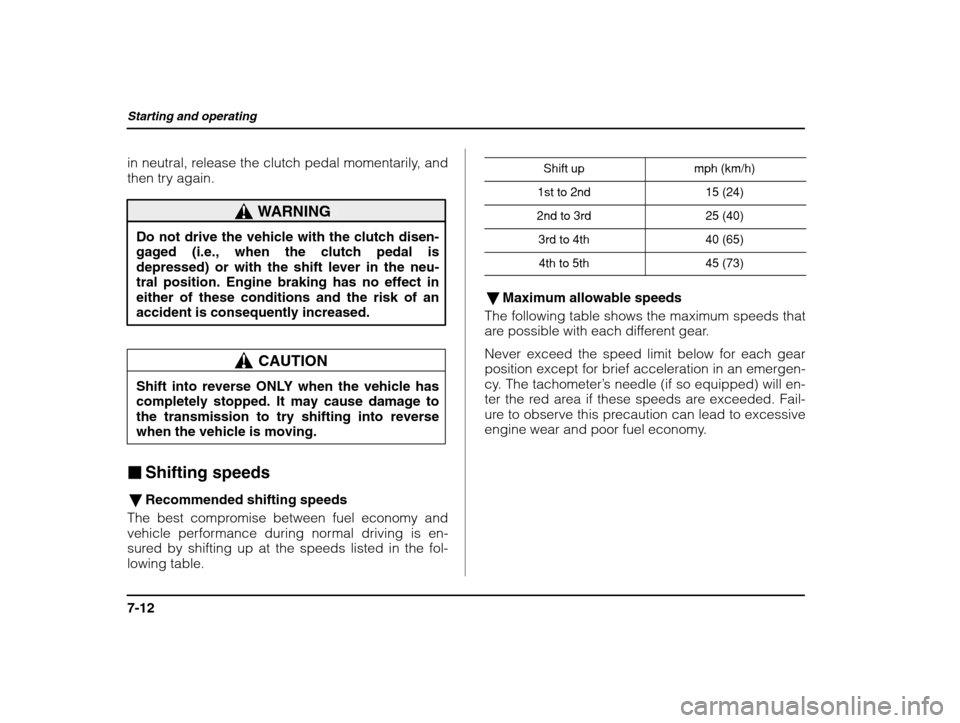2003 SUBARU IMPREZA WRX clutch
[x] Cancel search: clutchPage 230 of 425

Starting and operating
7-9
– CONTINUED –
Starting the engine
CAUTION
Do not operate the starter motor continuously
for more than ten seconds. If the engine fails to start after operating the starter for five to ten seconds, wait for ten seconds or more be-fore trying again.
� Manual transmission vehicle
1. Apply the parking brake.
2. Turn off unnecessary lights and accessories.
3. Press the clutch pedal to the floor and shift the
shift lever into neutral. Hold the clutch pedal to the
floor while starting the engine.
The starter motor will only operate when the clutch
pedal is pressed fully to the floor.
4. Turn the ignition switch to the “ON” position and
check the operation of the warning and indicatorlights. Refer to the “Warning and indicator light ” sec-
tion (chapter 3).
5. Turn the ignition switch to the “START” position
without depressing the accelerator pedal. Release
the key immediately after the engine has started. If the engine does not start within ten seconds, wait
a while and then turn the ignition switch to the
“START”
position again while depressing the accel-
erator pedal half way down.
6. Confirm that all warning and indicator lights have
gone off after the engine has started. The fuel injec-
tion system automatically lowers the idle speed as
the engine warms up. � Automatic transmission vehicle
1. Apply the parking brake.
2. Turn off unnecessary lights and accessories.
3. Shift the selector lever to the “P” or “N” position
(preferably “P” position).
The starter motor will only operate when the selectlever is at the “P” or “N” position.
4. Turn the ignition switch to the “ON” position and
check the operation of the warning and indicatorlights. Refer to the “Warning and indicator lights ”
section (chapter 3).
5. Turn the ignition switch to the “START” position
without depressing the accelerator pedal. Release
the key immediately after the engine has started.
If the engine does not start within ten seconds, wait
a while and then turn the ignition switch to the
“START” position again while depressing the accel-
Page 232 of 425

Starting and operating
7-11
– CONTINUED –
Stopping the engine
The ignition switch should be turned off only when the engine is idling.
WARNING
Do not stop the engine when the vehicle is moving. This will cause loss of power to the
power steering and the brake booster, makingsteering and braking more difficult. It could also result in accidental activation of the
“LOCK” position on the ignition switch, caus-
ing the steering wheel to lock. Manual transmission
The manual transmission is a fully synchromeshed
5-forward and 1-reverse speed transmission.
The shift pattern is shown on the shift lever knob.
When shifting from 5th gear to reverse gear, first re-
turn the shift lever to the neutral position then shift
into reverse gear.
To change gears, fully depress the clutch pedal,
move the shift lever, and gradually let up on the
clutch pedal.
If it is difficult to shift into gear, put the transmission
Page 233 of 425

Starting and operating
7-12
in neutral, release the clutch pedal momentarily, and
then try again.
WARNING
Do not drive the vehicle with the clutch disen- gaged (i.e., when the clutch pedal is
depressed) or with the shift lever in the neu-tral position. Engine braking has no effect ineither of these conditions and the risk of an
accident is consequently increased.
CAUTION
Shift into reverse ONLY when the vehicle has
completely stopped. It may cause damage tothe transmission to try shifting into reverse when the vehicle is moving.
� Shifting speeds
� Recommended shifting speeds
The best compromise between fuel economy and
vehicle performance during normal driving is en-
sured by shifting up at the speeds listed in the fol- lowing table. Shift up
mph (km/h)
1st to 2nd15 (24)
2nd to 3rd25 (40)
3rd to 4th40 (65)
4th to 5th45 (73)
�
Maximum allowable speeds
The following table shows the maximum speeds that
are possible with each different gear. Never exceed the speed limit below for each gear
position except for brief acceleration in an emergen-
cy. The tachometer ’s needle (if so equipped) will en-
ter the red area if these speeds are exceeded. Fail-
ure to observe this precaution can lead to excessive
engine wear and poor fuel economy.
Page 234 of 425

Starting and operating
7-13
– CONTINUED –
2.5 liter models (non-turbo)
mph (km/h)
RSTS, OUTBACK
1st29 (46)28 (45)
2nd48 (77)47 (75)
3rd68 (110)66 (106)
2.0 liter models (turbo)mph (km/h)
WRX
1st35 (56)
2nd61 (98)
3rd87 (140)
WARNING
When shifting down a gear, ensure that the
vehicle is not travelling at a speed exceedingthe Maximum Allowable Speed for the gearwhich is about to be selected. Failure to observe this precaution can lead to engine
over-revving and this in turn can result inengine damage.In addition, sudden application of engine
brakes when the vehicle is travelling on a slip-pery surface can lead to wheel locking; as a
consequence, control of the vehicle may be lost and the risk of an accident increased.
� Driving tips
Do not drive with your foot resting on the clutch ped- al and do not use the clutch to hold your vehicle at a standstill on an upgrade. Either of those actions maycause clutch damage.
Do not drive with your hand resting on the shift lever.This may cause wear on the transmission compo-nents.
When it is necessary to reduce vehicle speed due to
slow traffic, turning corners, or driving up steep hills,
downshift to a lower gear before the engine starts to
Page 251 of 425

Starting and operating
7-30
�To temporarily cancel the cruise con- trol
There are four ways to cancel the cruise control tem- porarily: � Depress the brake pedal.
� Pull the control lever in the “CANCEL” direction. (if
so equipped)� Depress the clutch pedal (manual transmission
vehicles only). � Shift the selector lever into the “N” position (auto-
matic transmission vehicles only).
To resume the cruise control after it has been tem- porarily canceled and with vehicle speed of about
20 mph (32 km/h) or more, push the control lever
upward in the “ACCEL, RESUME ” direction to return
to the original cruising speed automatically.
� To turn off the cruise control
There are two ways to turn off the cruise control: � Push the main switch again.
� Turn the ignition switch to the “ACC” or “LOCK”
position (but only when the vehicle is completely stopped). �
To change the cruising speed
� To increase the speed (by control lever)
Push the control lever upward in the “ACCEL, RE-
SUME” direction and hold it until the vehicle reaches
the desired speed. Then, release the control lever.
The vehicle speed at that moment will be memo-
rized and treated as the new set speed.
When the difference between the actual vehicle
speed and the set speed is less than 4 mph (6.8
km/h), the set speed can be increased 1 mph (1.6
km/h) each time by pressing the control lever up-
ward in the “ACCEL, RESUME ” direction quickly
within 0.5 second.
� To increase the speed (by accelerator pedal)
1. Depress the accelerator pedal to accelerate the
vehicle to the desired speed.
2. Push the control lever downward in the “SET,
COAST” direction once. Now the desired speed is
set and the vehicle will keep running at that speed
without depressing the accelerator pedal.
NOTE
If the difference between the actual vehicle speed when the control lever is pushed down-ward and the speed last time you set is less than
Page 289 of 425

Driving tips
8-36
safety’s sake, you should employ extra cau-
tion when towing a trailer and you should
never speed. You should also keep the follow-ing tips in mind:
� Before starting out on a trip
� Check that the vehicle and vehicle-to-hitch mount-
ing are in good condition. If any problems are
apparent, do not tow the trailer.� Check that the vehicle sits horizontally with the
trailer attached. If the vehicle is tipped sharply up at
the front and down at the rear, check the total trailer
weight, GVW, GAWs and tongue load again, then
confirm that the load and its distribution are accept-able.� Check that the tire pressures are correct.
� Check that the vehicle and trailer are connected
properly. Confirm that
–the trailer tongue is connected properly to the
hitch ball.– the trailer lights connector is connected prop-
erly and trailer ’s brake lights illuminate when the
vehicle’ s brake pedal is pressed, and that the trail-
er’ s turn signal lights flash when the vehicle ’s turn
signal lever is operated.– the safety chains are connected properly. –
all cargo in the trailer is secured safety in posi-
tion.– the side mirrors provide a good rearward field of
view without a significant blind spot.
� Sufficient time should be taken to learn the “feel”
of the vehicle/trailer combination before starting out
on a trip. In an area free of traffic, practice turning, stopping and backing up.
� Driving with a trailer
� You should allow for considerably more stopping
distance when towing a trailer. Avoid sudden brak-
ing because it may result in skidding or jackknifing
and loss of control. � Avoid abrupt starts and sudden accelerations. If
your vehicle has a manual transmission, always start
out in first gear and release the clutch at moderate
engine revolution.� Avoid uneven steering, sharp turns and rapid lane
changes.� Slow down before turning. Make a longer than
normal turning radius because the trailer wheels will
be closer than the vehicle wheels to the inside of the
turn. In a tight turn, the trailer could hit your vehicle.� Crosswinds will adversely affect the handling of
your vehicle and trailer, causing sway. Crosswindscan be due to weather conditions or the passing of
Page 324 of 425

11
11-1
– CONTINUED –
Maintenance schedule 11-3 . . . . . . . . . . . . . . . . . . . . . . . . . . . .
Maintenance precautions 11-3 . . . . . . . . . . . . . . . . . . . . . . . .
Engine hood 11-5 . . . . . . . . . . . . . . . . . . . . . . . . . . . . . . . . . . . . . . . . . .
Engine compartment overview 11-8 . . . . . . . . . . . . . . . . .
2.5 liter model 11-8 . . . . . . . . . . . . . . . . . . . . . . . . . . . . . . . . . . . . .
2.0 liter (Turbo) model 11-9 . . . . . . . . . . . . . . . . . . . . . . . . . . . .
Engine oil 11-10 . . . . . . . . . . . . . . . . . . . . . . . . . . . . . . . . . . . . . . . . . . . . . .
Checking the oil level 11-10 . . . . . . . . . . . . . . . . . . . . . . . . . . . . .
Changing the oil and oil filter 11-11 . . . . . . . . . . . . . . . . . . .
Recommended grade and viscosity 11-13 . . . . . . . . . . .
Recommended grade and viscosity under
severe driving conditions 11-15 . . . . . . . . . . . . . . . . . . . . . .
Synthetic oil 11-15
. . . . . . . . . . . . . . . . . . . . . . . . . . . . . . . . . . . . . . . .
Cooling system 11-15 . . . . . . . . . . . . . . . . . . . . . . . . . . . . . . . . . . . . . .
Cooling fan, hose and connections 11-16 . . . . . . . . . . . .
Engine coolant 11-16 . . . . . . . . . . . . . . . . . . . . . . . . . . . . . . . . . . . . .
Air cleaner element 11-20 . . . . . . . . . . . . . . . . . . . . . . . . . . . . . . . .
Replacing the air cleaner element 11-20 . . . . . . . . . . . . . .
Spark plugs 11-23 . . . . . . . . . . . . . . . . . . . . . . . . . . . . . . . . . . . . . . . . . . .
Recommended spark plugs 11-24 . . . . . . . . . . . . . . . . . . . . .
Drive belts 11-24 . . . . . . . . . . . . . . . . . . . . . . . . . . . . . . . . . . . . . . . . . . . . .
Manual transmission oil 11-25 . . . . . . . . . . . . . . . . . . . . . . . . . .
Checking the oil level 11-25 . . . . . . . . . . . . . . . . . . . . . . . . . . . . .
Recommended grade and viscosity 11-26 . . . . . . . . . . .
Automatic transmission fluid 11-27 . . . . . . . . . . . . . . . . . . .
Checking the fluid level 11-27 . . . . . . . . . . . . . . . . . . . . . . . . . .
Recommended fluid 11-29 . . . . . . . . . . . . . . . . . . . . . . . . . . . . . . . Front differential gear oil (AT vehicles) 11-29
. . . . .
Checking the oil level 11-29 . . . . . . . . . . . . . . . . . . . . . . . . . . . . .
Recommended grade and viscosity 11-30 . . . . . . . . . . .
Rear differential gear oil 11-31 . . . . . . . . . . . . . . . . . . . . . . . . . .
Checking the gear oil level 11-31 . . . . . . . . . . . . . . . . . . . . . . .
Recommended grade and viscosity 11-32 . . . . . . . . . . .
Power steering fluid 11-32 . . . . . . . . . . . . . . . . . . . . . . . . . . . . . . .
Checking the fluid level 11-32 . . . . . . . . . . . . . . . . . . . . . . . . . .
Recommended fluid 11-33 . . . . . . . . . . . . . . . . . . . . . . . . . . . . . . .
Brake fluid 11-34 . . . . . . . . . . . . . . . . . . . . . . . . . . . . . . . . . . . . . . . . . . . . .
Checking the fluid level 11-34 . . . . . . . . . . . . . . . . . . . . . . . . . .
Recommended brake fluid 11-34 . . . . . . . . . . . . . . . . . . . . . . .
Clutch fluid (MT vehicles) 11-35 . . . . . . . . . . . . . . . . . . . . . . . .
Checking the fluid level 11-35 . . . . . . . . . . . . . . . . . . . . . . . . . .
Recommended clutch fluid 11-36 . . . . . . . . . . . . . . . . . . . . . .
Brake booster 11-36 . . . . . . . . . . . . . . . . . . . . . . . . . . . . . . . . . . . . . . . .
Brake pedal 11-37 . . . . . . . . . . . . . . . . . . . . . . . . . . . . . . . . . . . . . . . . . . .
Checking the brake pedal free play 11-37 . . . . . . . . . . . .
Checking the brake pedal reserve distance 11-37 . .
Clutch pedal (MT vehicles) 11-38 . . . . . . . . . . . . . . . . . . . . . .
Checking the clutch function 11-38 . . . . . . . . . . . . . . . . . . . .
Checking the clutch pedal free play 11-38 . . . . . . . . . . .
Replacement of brake pad and lining 11-39 . . . . . . . .
Breaking-in of new brake pads and linings 11-39 . . .
Parking brake stroke 11-40 . . . . . . . . . . . . . . . . . . . . . . . . . . . . . .
Tires and wheels 11-41 . . . . . . . . . . . . . . . . . . . . . . . . . . . . . . . . . . . .
Types of tires 11-41 . . . . . . . . . . . . . . . . . . . . . . . . . . . . . . . . . . . . . . .
Maintenance and service
Page 331 of 425

Maintenance and service
11-8
Engine compartment overview �2.5 liter model
1) Manual transmission oil level gauge
(MT) (page 11-25) or Differential
gear oil level gauge (AT) (page 11-29)
2) Air cleaner element (page 11-20)
3) Clutch fluid reservoir (page 11-35)
4) Automatic transmission fluid level gauge (page 11-27)
5) Brake fluid reservoir (page 11-34)
6) Windshield washer tank (page
11-50)
7) Fuse box (page 11-56)
8) Battery (page 11-54)
9) Engine oil filler cap (page 11-10)
10) Engine coolant reservoir (page 11-16)
11) Radiator cap (page 11-16)
12) Engine oil level gauge (page 11-10)
13) Power steering fluid reservoir (page 11-32)